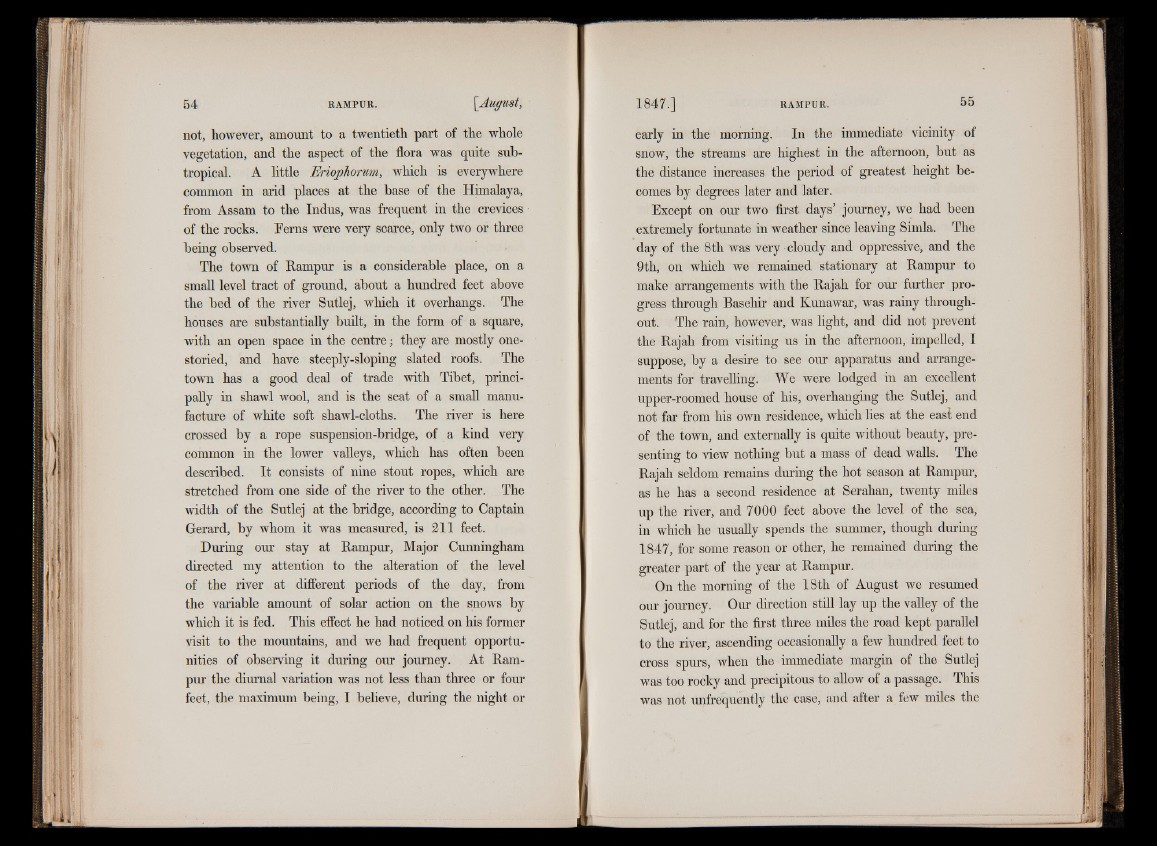
not, however, amount to a twentieth part of the whole
vegetation, and the aspect of the flora was quite subtropical.
A little Eriophorum, which is everywhere
common in arid places at the base of the Himalaya,
from Assam to the Indus, was frequent in the crevices
of the rocks, herns were very scarce, only two or three
being observed.
The town of Rampur is a considerable place, on a
small level tract of ground, about a hundred feet above
the bed of the river Sutlej, which it overhangs. The
houses are substantially built, in the form of a square,
with an open space in the centre | they are mostly one-
storied, and have steeply-sloping slated roofs. The
town has a good deal of trade with Tibet, principally
in shawl wool, and is the seat of a small manufacture
of white soft shawl-cloths. The river is here
crossed by a rope suspension-bridge, of a kind very
common in the lower valleys, which has often been
described. It consists of nine stout ropes, which are
stretched from one side of the river to the other. The
width of the Sutlej at the bridge, according to Captain
Gerard, by whom it was measured, is 211 feet.
During our stay at Rampur, Major Cunningham
directed my attention to the alteration of the level
of the river at different periods of the day, from
the variable amount of solar action on the snows by
which it is fed. This effect he had noticed on his former
visit to the mountains, and we had frequent opportunities
of observing it during our journey. At Rampur
the diurnal variation was not less than three or four
feet, the maximum being, I believe, during the night or
early in the morning. In the immediate vicinity of
snow, the streams are highest in the afternoon, but as
the distance increases the period of greatest height becomes
by degrees later and later.
Except on our two first days’ journey, we had been
extremely fortunate in weather since leaving Simla. The
day of the 8th was very cloudy and oppressive, and the
9th, on which we remained stationary at Rampur to
make arrangements with the Rajah for our further progress
through Basehir and Kunawar, was rainy throughout.
The rain, however, was fight, and did not prevent
the Rajah from visiting us in the afternoon, impelled, I
suppose, by a desire to see our apparatus and arrangements
for travelling. We were lodged in an excellent
upper-roomed house of his, overhanging the Sutlej, and
not far from his own residence, which lies at the east end
of the town, and externally is quite without beauty, presenting
to view nothing but a mass of dead walls. The
Rajah seldom remains during the hot season at Rampur,
as he has a second residence at Serahan, twenty miles
up the river, and 7000 feet above the level of the sea,
in which he usually spends the summer, though during
1847, for some reason or other, he remained during the
greater part of the year at Rampur.
On the morning of the 18th of August we resumed
our journey. Our direction still lay up the valley of the
Sutlej, and for the first three miles the road kept parallel
to the river, ascending occasionally a few hundred feet to
cross spurs, when the immediate margin of the Sutlej
was too rocky and precipitous to allow of a passage. This
was not unfrequently the case, and after a few miles the